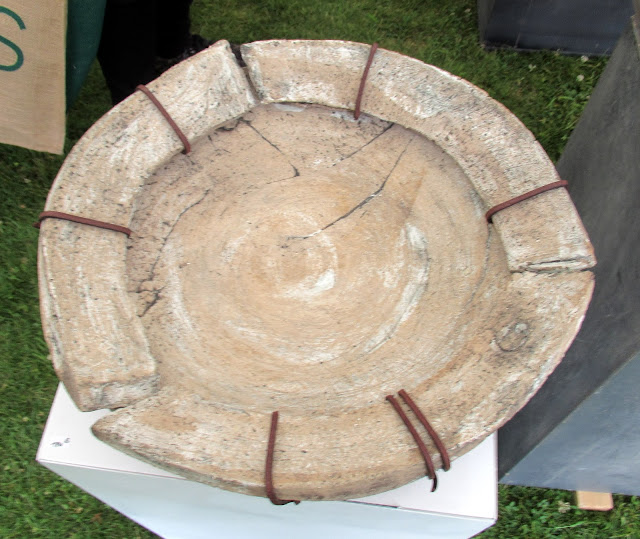Potfest at Compton Verney.
More ceramics in this post on the Potfest at Compton Verney. You can see the first post here
Peter Hayes:
The distinctive appearance of Peter Hayes' ceramics comes from the techniques like Raku firing to which he subjects them, but also from the fact that he submerges them in the flowing river beside his studio, or sends them to Cornwall to be washed in the sea for months at a time. The water washes minerals such as copper and metal oxides into the basic white clay with which Hayes works, creating a characteristic green-blue 'blush' in his sculptures along with random elements that make every piece unique.
The effect is to create objects that many feel look ancient and perhaps even a little alien. Hayes' work is generally finished by waxing and polishing. 'I have always been interested in: why and how 'things' are made of clay. One of the major introductions I had to ceramics was digging Neolithic iron age and Roman samien shards on archaeological digs somewhere in Wales while trying to survive as an art student in Birmingham. I am naturally drawn to shapes of artefacts and objects from other cultures and other times, but that remain timeless...
In practice I go by the seat of my pants. I have always worked this way, not going by any particular rules or methods. I find it joyful to work with many different materials. Each has its own character, its own limits, its own tolerance - some materials fight back, some play the game. Finally, I think it's the material that is in charge and it will only let you make what it wants. It is my job to push it to its limits and somehow an equilibrium is made between maker and material'.
'In 1972 I went to study ceramics in Lesotho, where I was privileged to work with the Basotho. They have a unique way of making burnished pots. Unlike the Zulu's black burnished work, the Basotho pots are bright red, sometimes orange. Though the method and tools are very basic, the finished surfaces are wonderfully smooth to the touch. By using a polished pebble, usually gathered from the riverbank, the leather hard surface is rubbed and polished to compress the clay. By adding red slip to the surface, which has been very finely ground, a highly polished burnished surface is created.
The Basotho used dry cow-dung for firing the pots. The pots are usually placed upside down to create a pyramid shape. The dry cow dung is then packed all around and covered with various bits of corrugated iron and flattened out metal oil drums and then set alight. The whole firing process only takes 3 or 4 hours and temperatures of 600 degrees can be achieved. The finished pieces are very pleasing to the eye, with high red burnished surfaces and black carbon markings where the fuel was not entirely burnt away.
I have developed this technique with only slight modifications as I burnished over textured surfaces and raise the temperature to approximately 1060 degrees. I have adapted a gas fired kiln where each piece of work is placed very close together, without touching, and a long slow flame is allowed to lick around the piece to give a very dark, red burnished appearance'.
Two ceramicists exhibiting on this stall - they had come all the way from Germany for Potfest.
Some monumental new pieces by Eddie Curtis. Even though they are immediately recognizably his, they are a new departure, quite different from his previous work. Absolutely stunning (and very expensive, unfortunately).
Curtis studied ceramics at Bath Academy of Art. In 1979 he, and Margaret Curtis, established a studio at Middle Rigg where they both continue to work today. The first output from the studio was oven to tableware but over the years the emphasis changed to more individually unique works. He developed an almost obsessive passion to master the very demanding but equally rewarding production of copper red porcelain culminating in 2010 with a hugely successful exhibition with Margaret Curtis entitled 'Curtis Red'.
Around this same time he paid a chance visit to a stretch of coastline near to his home town. This visit led to a massive change of direction and a consequently inspired body of work 'The Blast Series' which you can read about here and here . For more on Eddie Curtis use the search facility on the right column of this blog, there are too many entries for me to list them here.
(I was disappointed when I realised that Margaret Curtis did not have a stall at Potfest, but as she explained when I talked to her, she currently has a major exhibition at the Stratford gallery where all her current work is on display).



























No comments:
Post a Comment